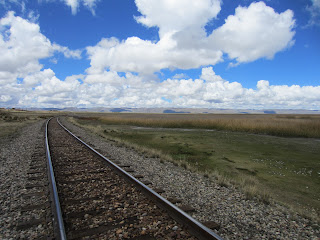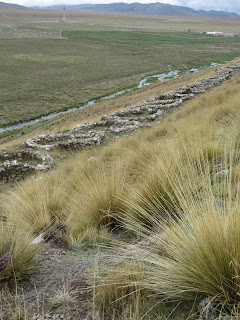My socio/counterpart Jenny is also my host sister. I’ll be interested to see how working and living together pans out. I think it’ll be good because she seems really supportive so far and at least she can’t hide from me.
We got to the house and I met my family. There are 9 brothers and sisters between the ages of 35 and 11. Jenny, who’s 30, lives at home and works at the municipality. Stephanie, 14, and David, 11 also live at home. There’s another kid named Anderson who is 16 and lives at home, but he was on a graduation trip, so I haven’t met him yet. The rest work in Lima or go to the university in Cerro de Pasco and they all come home on the weekends. I got to meet Carlos, Eber, and Elena briefly before I left on Saturday morning. The mom is a lovely sweet lady without any teeth. She takes care of everybody and is very cariñoso. The dad works in construction and is also very kind and plays with the kids and talks to me a lot. I’m excited to have the experience of a big family. It’s only been the four for me growing up and my cousins are relatively few and widespread. I wonder what it’ll be like to have so much going on during the weekends. They’ve said they want to embrace me like another sister and I’m happy to be a part of it.
I was really excited to find out that my tia and tio (campo host mom and dad) speak Quechua. I was afraid I wasn’t going to get a chance to learn and am going to ask them to teach me. Though their Quechua accents and my tia’s lack of teeth makes it harder for me to understand them.
The house is lovely. It’s on the outskirts of town so it feels like the campo, but it’s only 20 minutes or so walking to get to the municipality. We’re at the base of a big hill and there’s a good road for running nearby. I tried it and managed a huffy walk/shuffle, but it’ll get better.
The house is huge and seems like it was a hotel at one point. But is has to be big to hold so many hermanos. All the rooms are upstairs and there’s a big room downstairs that’s mostly empty. They told me they use it for parties. Most of the socializing is in the kitchen which is a separate little building in the yard. They have a green space and little fenced areas for their 4 sheep. Two are little lambs and the two big ones are going to be Christmas and New Yearspachamanca, respectively. It takes some getting used to, but I heard from another volunteer that his family is going to eat their cat, so it could be more graphic.
The latrine is out in the yard. It’s a hole in the ground with four walls and no roof. It will be interesting during the rainy season. But I was already getting used to carrying my TP around and putting on lots of sweaters to go to the bathroom.
The house has no heating, so the cold can feel inescapable at times. I’m sure I’ll get used to it, but it still felt strange to wear my knit hat and two pairs of pants while eating dinner.
The kitchen is large with a big table for everyone to sit at. It has a dirt floor and a stove that burns cancha, which is a type of grass. They also burn cow chips when they’re around. The have a gas stove as well, but it doesn’t get a lot of use because tia is used to the other one and gas is expensive. They recently got some guinea pigs, so they run around my feet while I eat meals and make their cuycuy noises. There are two chickens that sleep in a little box in the kitchen and they let them out during the day. Below are Tia Rufina with a cuy, Stephanie with a kitten, and David with his puppy Koki.
My tia also bought two kittens while I was there because they saw some mice. They are super tiny and were really fun to play with. There are four dogs and one of them is a little puppy. They roam around in the yard and outside. They barked at me a lot at first, were slightly menacing, and wouldn’t let me near them. I followed prima Casey’s example and gave them some bread, and now we’re best friends. Two of them follow me on runs in the morning and sometimes to work. All of them give me lots of wags when I come up to them and want to be petted. It feels so good to be in a house full of animals.
The food was interesting. For one, when I told Peruvians I was going to Junin, they’d say, “Oh, you’re going to eat a lot of jerky.” I started to imagine the wonderful black peppercorn buffalo jerky I ate while backpacking and roadtripping this summer and was thrilled. It turns out that this is where Junin jerky comes from.
There were also more carbs than I have ever encountered for such a sustained period of time. We’d have bread and porridge like stuff for breakfast. Lunch is noodle soup then rice with potatoes and some token meat and vegetables. Once it was fish, another time was sheep intestine which is very chewy. Snack is bread and tea and dinner is a repeat of lunch. I felt grateful to be well fed, but my body has a hard time with that diet. I’m going to see if I cook breakfast and lunch for myself and share dinner to still be part of the family. I got to try some interesting new things, like sheep intestine. And dried potato soup. Friday was the feria market and the food there merits its own post. I’ll leave you with live toads in a blender.
I also got a taste of some Peace Corps style inertia. When I got there on Tuesday, Jenny told me we were going to plant trees that afternoon. We ended up planting the trees on Thursday and in between there was a lot of me sitting around in the municipality writing letters. But it got people to know my face and is good practice for all the waiting I’ll be doing in the future.
While I was hanging around in my tree planting pants, they told me I was going to meet the mayor. I felt unprepared and nervous, but he was very nice and said he wants to support me in whatever I need. Institutional apathy is a big problem for volunteers, so that was awesome. I have another socio named Anderson who is the regidor of environment for the district. He has an environmental radio show once a week that he broadcasts from Carhuamayo. I went to listen and he asked me for an interview. So I ended up talking on the Carhuamayo radio for 20 minutes about everything from global climate change to my favorite Peruvian beer. Again, I was blindsided, but I think it went well and people in other towns were mentioning it to the volunteers.
I spent a bunch of time wandering around town and talking with the folks that approached me. I also went to a parent’s meeting at David’s school and got roped into designing their diplomas. I played soccer with kids and chatted up tienda owners. The tree planting in the plaza was really fun and successful. It felt amazing to work hard with my body after so much lethargy. Folks would stop to oogle and ask questions. They may have been looking at the tiny hat I had to borrow, but the sun is fuerte and style doesn´t count for much in the campo. Or they could have been staring at how we loaded all our trees into a mototaxi to go from the nursery to the plaza.
Women from a mother’s group and from a community group called Vaso de Leche came to help us plant, so I made some good contacts with them. It seems like there are a ton of projects and a lot of environmental interest as well as a lot of support. I feel like there’s the potential for me to do some good work. Everyone says that the number one problem is a lack of environmental consciousness, so I’ll go for that first.
I’m excited to teach vacaciones utiles classes when I get back. I’m thinking an environmental club, a few English classes because everyone asks for them, and ultimate frisbee.
There’s only two more weeks of training. I can’t wait to see everyone tomorrow and hear their stories. All the veteran volunteers say that this period is basically a huge bender because everyone is over training. I’m not necessarily looking forward to that part, but I’m going to try to go out more. This is my last chance to build my gringo relationships before we disperse for good.
Here are some fun photos to leave you with. I played futbol with these guys and was the worst one. My hermanito David is in the center with the red sweater. And don´t judge me for wearing the same flannel in every picture. It´s hard to pack for ten days in one backpack and I didn´t bring a lot of diversity of long sleeves.






























